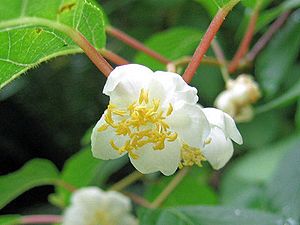Actinidia polygama facts for kids
Actinidia polygama (also known as silver vine, 개다래; gaedarae, matatabi (マタタビ), and cat powder) is a special kind of kiwifruit. It belongs to the Actinidiaceae family, which is the same family as the fuzzy green kiwis you might eat!
Quick facts for kids Actinidia polygama |
|
|---|---|
 |
|
| Scientific classification | |
| Genus: |
Actinidia
|
| Species: |
polygama
|
This plant grows in the mountains of Korea, Japan, and China. You can find it at high places, usually between 500 and 1900 meters (about 1,640 to 6,230 feet) above sea level.
Silver vine is a climbing plant that can grow quite tall, reaching up to 5 to 6 meters (about 16 to 20 feet) high. It's a deciduous plant, meaning its leaves fall off in the autumn. It can handle very cold weather, even temperatures as low as -30°C (-22°F).
The leaves of the silver vine are very pretty. They are about 6 to 13 centimeters (2.4 to 5.1 inches) long and 4 to 9 centimeters (1.6 to 3.5 inches) wide. What makes them special is their silver and white markings. These colorful spots help you spot the plant from far away! However, when it's time for the flowers to bloom, the leaves turn completely green.
The silver vine flowers bloom from late June to early July. The flowers are white and about 2.5 centimeters (1 inch) wide. Each flower only lasts for about 2 to 3 days. After the flowers, the plant starts to grow small, egg-shaped fruits. These fruits are yellow to reddish-yellow and have many seeds inside. They become ripe from September to October. The fruit is about 1.5 centimeters (0.6 inches) wide and 3 to 4 centimeters (1.2 to 1.6 inches) long. If you cut one open, it looks a lot like a common kiwifruit inside, but it's orange instead of green!
This plant likes soil that is moist but drains well. It can grow in places with some shade or in full sunshine. Silver vine grows quickly, making it a great plant to cover a fence or a trellis. More and more people are growing it for its tasty fruit.
Contents
What Silver Vine is Used For
Silver vine has many different uses, from helping people feel better to being a special treat for cats!
For Health and Wellness
For hundreds of years, people have used silver vine in traditional medicine. It was thought to help keep people healthy. In places like China and Japan, it was used for many general health issues. For example, people believed it could help with aches and pains or support a healthy heart.
In Korean Buddhism, people would soak silver vine in traditional sauces. They used it to help with pain or to feel more energetic. There's even an old saying that "In ancient times, tired travelers would regain energy to continue their journey after eating the fruit of silver vine."
The leaves of silver vine are also packed with good things like vitamin C and vitamin E. These are important for keeping you healthy!
In the Kitchen
The fruit of the silver vine, which looks a bit like an acorn, can be eaten in many ways. You can eat it raw with a little salt, or fry it in oil. Some people add it to rice or mix it with sesame seeds and mayonnaise to put on salads.
The fruit can also be used to make drinks like Matatabi sake or a fruit wine. You can also get juice from it. The leaves, buds, and stems can be ground into a powder or steamed and steeped to make tea. You can even add mint or sugar to the tea for different flavors!
Other Uses
When the leaves and stems are ground a bit coarser than for tea, they make Matatabi grass. This is sometimes used as bath salts. The vine itself is also used to make traditional crafts. People even collect the sap from the plant to make lotions.
For Pets
Silver vine is famous for making cats feel really happy and playful! It's a lot like catnip, but for some cats, the reaction is even stronger. If a cat doesn't react to catnip, they might still love silver vine powder, which is made from the dried fruit.
When cats get silver vine, they often start rolling around, rubbing their chin and cheeks on things, drooling a bit, and licking. This fun effect usually lasts between 5 and 30 minutes. After that, cats usually don't react to the plant for an hour or more.
Scientists have found that cats are attracted to special chemicals called iridoids in silver vine. These chemicals also help to keep mosquitos away! So, when cats rub against the plants, they might be putting a natural bug spray on themselves to protect against mosquito bites.
See also
 In Spanish: Actinidia polygama para niños
In Spanish: Actinidia polygama para niños


